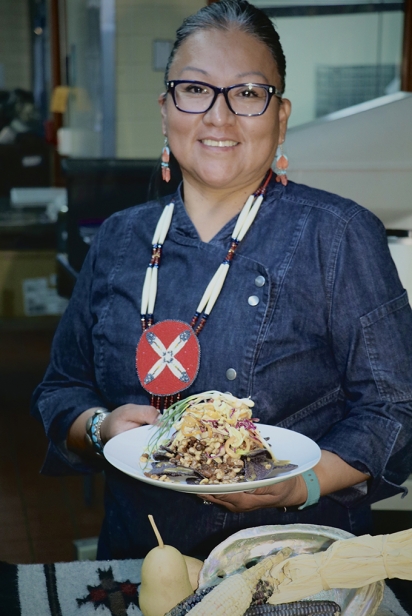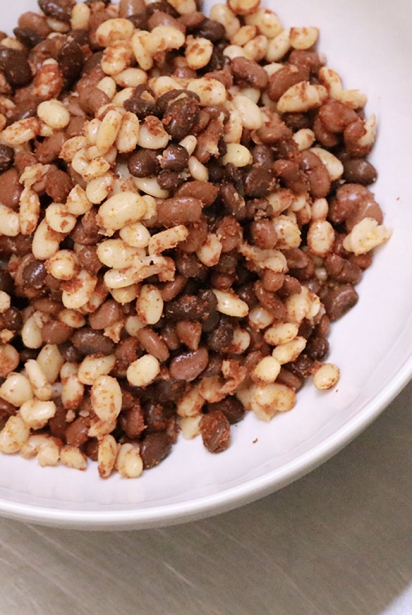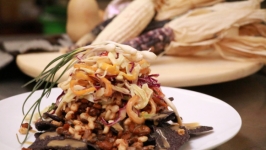The Tepary Bean
As Arizonans, we all know the monsoon season—that mercurial switch from sun-scorched morning to afternoon deluge is one of the desert’s most remarkable feats. What you may not know is that from this moisture miracle comes a perfectly adapted desert treat cultivated by Indigenous people for centuries: the tepary bean.
This small wonder of nature thrives when planted in arroyos during monsoon rains, which provide enough water for the tepary to grow to maturity and, in turn, provide a legume that punches above its weight in nutrition and taste.
The pinto’s healthier, more colorful cousin
You might have noticed the magic bean increasing in prominence, from “The Sioux Chef” Sean Sherman’s recipe for chile-agave glazed tepary beans in The New York Times to appearances on Valley menus, such as cushioning braised Niman Ranch beef at FnB or molded into Arizona Wilderness Brewing Co.’s legendary tepary bean burger.
But what do they taste like? An earthier, meatier cousin of the pinto bean, tepary beans hold their shape, making them a great addition to stews or salads where they can provide depth of flavor without getting lost. They also taste great mashed into plant-based patties or blended into dips or even a desert-inspired hummus. Each of the three colors of bean—white, brown and the rarer black tepary—offers a variation on the nutty, savory theme.
Beyond their rich flavor, you might choose tepary beans for their nutritional benefits. Considered a superfood by Arizona’s Indigenous peoples long before a marketer dreamed up that term, tepary beans are a low-glycemic option and pack a ton of protein. For the brown variety, that means 23 grams of protein in just half a cup, as well as fiber and minerals, including folate, iron, magnesium, potassium and zinc. Their high ratio of protein and fiber to sugar is the result of a beautiful adaptation of efficiency to the desert conditions in which the plant was cultivated.
Turning to the tepary to be climate conscious
Known scientifically as Phaseolus acutifolius—named for its slender, wiry stems crowned with small, pointed leaves—tepary is a resilient and nutritious legume native to the arid Sonoran regions of the Southwestern United States and Northern Mexico. Cultivated by Indigenous peoples such as the Tohono O’odham, Akimel O’odham and Pima, tepary beans have been an essential part of traditional diets and cultural heritage for generations.
Water scarcity is no stranger to Arizonans, and it’s hard to find a better steward of water than the humble tepary bean. These compact bush beans are uniquely suited to withstand extreme heat and drought conditions, thanks to their deep root systems and ability to add and retain nitrogen in the soil, which enhances fertility. They are the epitome of climate-smart eating.
One Native chef’s innovative creations
With their rich history, nutritional benefits and adaptability to harsh environments, tepary beans are not only a culinary delight but also a symbol of resilience and sustainability in the face of adversity. Tepary beans have risen alongside an interest in eating an environmentally friendly diet of foods native to Arizona and a renaissance of bold Indigenous cuisine.
A perfect example of an Indigenous chef bringing the tepary bean to prominence is Denella Belin of Nella’s Innovative Kreations, who has made it a central theme in her menu.
Growing up in Tuba City, Belin watched her mom run a catering business on the Navajo reservation. She helped make dumplings and assisted in butchering sheep for roast mutton. After enrolling at Scottsdale Culinary Institute, Belin mastered fine French cooking techniques and focused on excelling in the modern culinary world. However, outside the kitchen, she felt almost invisible while trying to acclimate to city life. It was rare to see Indigenous ingredients on menus.
Her imagination was first captured by the tepary bean while working as a sous chef for the Tohono O’odham Nation’s Desert Diamond Casino in Glendale. She felt honored that the Tohono O’odham provided her with the opportunity to use tribal foods to inspire her menus. Here, Belin got to know tepary beans as a staple, such as the base for chili used on Native tacos. A turning point came when Belin volunteered to help with kitchen prep for a luncheon hosting renowned Indigenous chef Nephi Craig. Ever open to learning, Belin was struck by Craig’s excitement and dedication to tribal foods.
Walking away from the luncheon, Belin asked herself, “What do I represent?” She had long cherished sharing her traditional dishes of blue corn mush or roast mutton sandwiches. Why shouldn’t she dedicate herself to sharing these foods that meant so much to who she is?
Launching an Indigenous catering company
This realization unlocked a new sense of creativity and freedom in the kitchen. It was the beginning of her true culinary journey that she continues today as the owner of Nella’s Innovative Kreations, a catering and cooking class business that she established through Local First Arizona’s restaurant incubator program.
In launching her business, she turned to new interpretations of familiar ingredients, most prominently the tepary bean. Freshly opened to new possibilities, Belin pondered how to showcase the beans in a new way.
To start, she created her base, a tri-color union of the beans melded into a distinctive meaty and rich foundation.
It made sense to Belin to pair the beans with another Indigenous superfood: blue corn, formed into crisp tortilla chips. Rather than veer into stodgy or fatty nacho cheese sauce, she turned to a fresh, crisp cabbage slaw pulled together with maple balsamic vinaigrette.
The resulting dish, Denella’s Tepary Bean Confetti Nachos, became the most popular dish on her menu. It was one of four menu items that anchored her original offerings.
Belin said that after clarifying her inspirations, she felt free to adventure across inventive ingredient combinations, and while other chefs sometimes questioned them, her ideas typically succeeded more often than failed.
A related passion for Belin is teaching classes for kids on food and nutrition, including her Native foods. Although usually at a loss when they first encounter the tepary bean, Belin is proud to hear exclamations of “What is that?” quickly convert to “Can I have seconds?”
Where to buy tepary beans
Ready to whip up a bowl of these magic beans for yourself?
As an ingredient on the rise, buying tepary beans may not be as straightforward as running down to the corner store—at least not yet. Best to go right to the source and purchase directly from Ramona Farms, an Akimel O’odham grower on the Gila River reservation in Sacaton. Their website offers non-GMO, pesticide- and herbicide-free heirloom tepary beans, or bavi, in white, brown and black varieties.
Other emerging options include the Blue Sky Organic Farms store in Litchfield Park, the Heard Museum gift shop, some coffee shops and select Whole Foods stores.
Tepary bean availability should expand in coming years, particularly as they are a crop that has been designated for greater promotion and cultivation by the Arizona Alliance for Climate-Smart Foods, a group led by the University of Arizona, the Arizona-Sonora Desert Museum, Local First Arizona and other partners.
Funded by a $5 million grant from the U.S. Department of Agriculture, the alliance is partnering with farmers around the state to cultivate more desert-adapted crops, including the tepary bean, prickly pear, agave and more. The initiative will also develop product labeling so chefs and grocery shoppers can easily identify both desert-adapted ingredients and growers who are good stewards of our limited water and land resources.
Create your own bean base
To prepare tepary beans, Belin recommends placing them in a crockpot on medium-high for approximately three to four hours. Ensure there’s ample water in the pot. Tepary beans are forgiving, even if slightly overcooked.
Once cooked, drain the beans. The flavorful broth in the pot can be preserved for use in other recipes by freezing it for later. Avoid soaking and rinsing the beans; instead, spread them on a sheet pan to air dry before refrigerating, a method that helps retain their nutrients.
Before long, your friends and family too will be asking, “Can I have seconds?”








